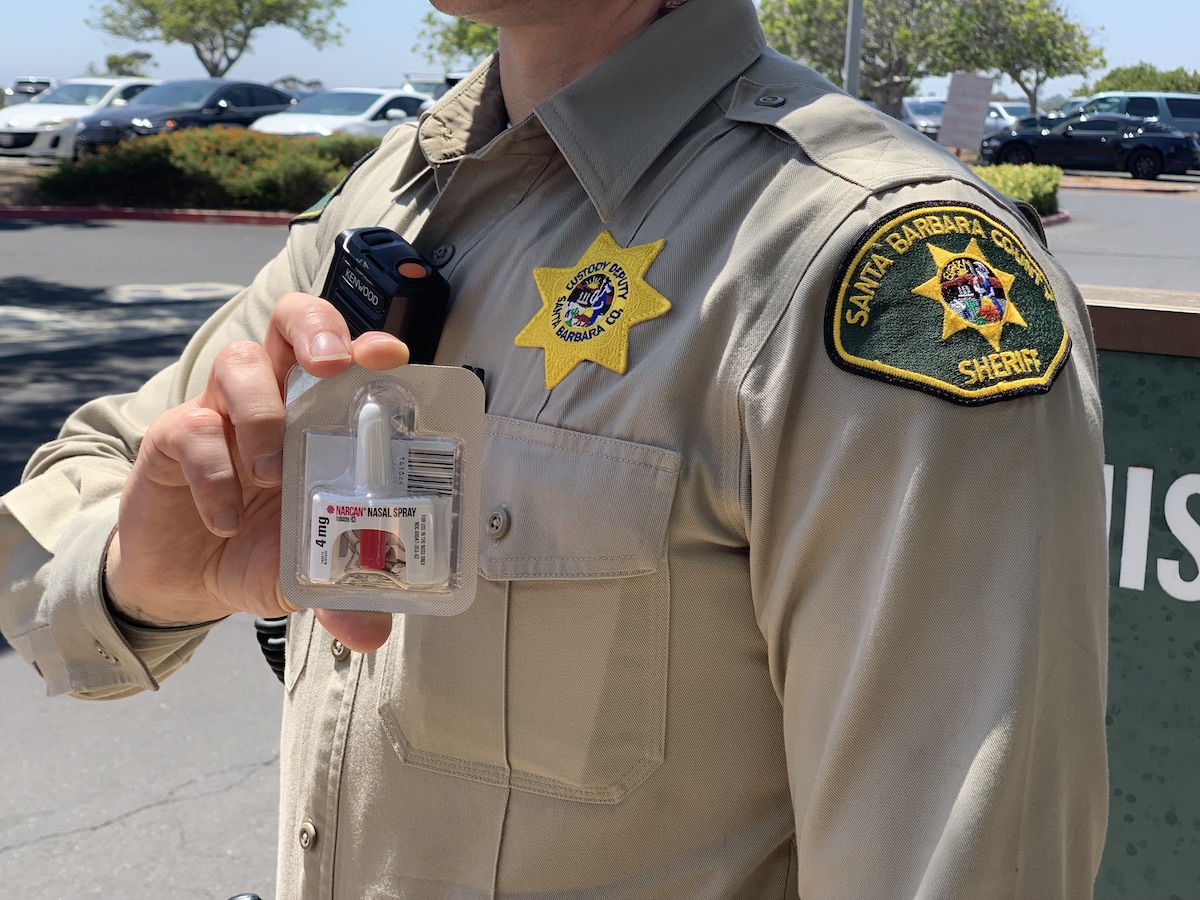Naloxone Saves a Life on a Goleta Sidewalk
Sheriff's Deputy Reverses Opioid Overdose

Curbing illegal opioids remains a target for law enforcement statewide, but in Goleta on Monday night, a man was saved from an overdose by a Sheriff’s deputy on patrol.
The unidentified man was lying on a sidewalk on the 5900 block of Hollister Avenue, in the heart of the city’s Old Town, when the deputy noticed him around 11:45 p.m. on November 28. Recognizing the overdose signs of a lack of response, slowed breathing, and a blue tinge to lips and fingernails, the deputy called for an ambulance and administered naloxone.
Since the Sheriff’s Office started its naloxone program in 2017, this is the 97th time a life has been saved by Sheriff’s deputies through the rapid use of the opioid-reversing medication. Administered as an inhalant, naloxone, also known by its brand name Narcan, became more widespread when California’s Department of Health Care Services made it available to substance abuse and homeless organizations, as well as first responders, schools, and libraries. The Santa Barbara City Police Department began using it in 2019, while Pacific Pride Foundation was the first to provide Narcan kits and train people in their use in 2016, through its syringe exchange program in collaboration with Santa Barbara County’s Behavioral Wellness program. It’s not a universal panacea, however, as the Sheriff’s Office records reflect 104 attempts to use it to revive a victim over the past six years.
The statistics associated with opioid overdoses are grim. They only grew grimmer once the cheap synthetic opioid fentanyl became widespread, and people took it knowingly and unknowingly. Sheriff Bill Brown’s Project Opioid program estimated in May 2022 that deaths in Santa Barbara County due to fentanyl had increased 81 percent since 2019 and that the drug was in the bodies of 50.4 percent of the people who overdosed and died in 2021. From January 2021 to January 2022, there were about 133 fatal overdoses, 86 of them opioid-related. Over the previous four years, the numbers rose consistently from 74 overdose fatalities in 2017, 38 of them opioid-related.
Fentanyl is 50 times stronger than heroin, according to California Attorney General Rob Bonta’s office, and a small amount — just 2 milligrams — can cause an overdose. Other drugs like heroin, methamphetamine, and cocaine can be laced with an unknown quantity of fentanyl, a danger that led to a state Public Health department program that distributes fentanyl test strips. On the black market, fentanyl is sold in pills resembling oxycodone as well as rainbow-colored pills, which Bonta’s office believes likely to be aimed at younger people.
The state Attorney General’s Office has collaborated with local agencies and the Department of Justice since April 2021, seizing more than 4 million fentanyl pills and almost 900 pounds of fentanyl powder. The synthetic was implicated in nearly all of the cases brought over the past four years by the federal U.S. Attorney’s office in Los Angeles against 51 people, who allegedly sold drugs that led to a fatal poisoning.
The alarming increase in opioid deaths traces back to the 1990s, when legal drug manufacturers lied about the addictive properties of the new prescription opioids they’d developed. Bonta’s office stated that in cooperation with participating states and local governments, they’d won settlements totaling $38.5 billion from three major pharmaceutical distributors — Cardinal, McKesson, and AmerisourceBergen — manufacturer and marketer Johnson & Johnson, manufacturers Allergan and Teva, and promoter McKinsey & Company. The settlements include $6 billion from Purdue Pharma and the Sackler family, who had taken the small Purdue company — which made earwax removers and laxatives, as the New Yorker reported in 2017 — into a behemoth based on its opioid pain-reliever OxyContin while consistently downplaying how addictive it was.
For California law enforcement, saving the life of a victim is outweighing the prospect of a prosecution for illegal possession. The Sheriff’s Office asks that if an overdose is suspected, call 9-1-1: “California’s 911 Good Samaritan law, AB 472, provides limited protection from arrest, charge, and prosecution for people who seek emergency medical assistance at the scene of a suspected drug overdose.”
Support the Santa Barbara Independent through a long-term or a single contribution.



